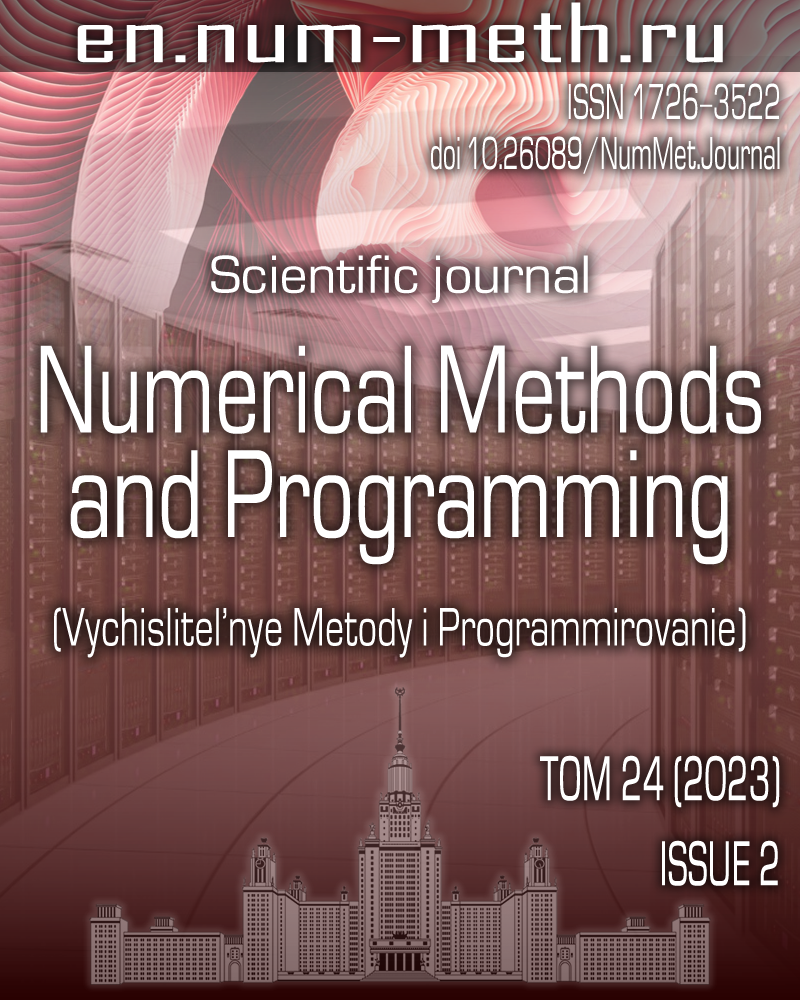DOI: https://doi.org/10.26089/NumMet.v24r212
Explicit-implicit scheme CABARETI–NH for the equations of a weakly compressible fluid dynamics
Keywords:
Abstract
In this paper, an explicit-implicit conservative-characteristic scheme CABARETI–NH (CABARET Implicit Non-Hydrostatic), based on the CABARET scheme, for a hyperbolised system of Navier–Stokes equations is considered. Implicitness along one spatial direction allows the time step on computational grids with a large aspect ratio of cells to be significantly increased. A hyperbolic sweep method is used to resolve the introduced implicit part of the scheme. This keeps the same level of computational efficiency as explicit schemes. The results of model validation on the laboratory experiment of three-dimensional gravitational flow of a stratified fluid are presented.
Published
Issue
Section
References
- G. I. Marchuk, V. P. Dymnikov, and V. B. Zalesnyi, Mathematical Models in Geophysical Hydrodynamics and Numerical Methods for Their Implementation (Gidrometeoizdat, Leningrad, 1987) [in Russian].
- J. Pedlosky, Geophysical Fluid Dynamics (Springer, New York, 1987). doi10.1007/978-1-4612-4650-3.
- P. Müller, The Equations of Oceanic Motions (Cambridge University Press, Cambridge, 2006).
- G. K. Vallis, Atmospheric and Oceanic Fluid Dynamics: Fundamentals and Large-scale Circulation (Cambridge University Press, Cambridge, 2017).
- V. M. Goloviznin, Pavel A. Maiorov, Petr A. Maiorov, and A. V. Solovjev, “New Numerical Algorithm for the Multi-Layer Shallow Water Equations Based on the Hyperbolic Decomposition and the CABARET Scheme,” Morsk. Gidrofiz. Zh. 35 (6), 600-620 (2019) [J. Phys. Oceanogr. 26 (6), 528-546 (2019).
doi 10.22449/1573-160x-2019-6-528-546]. - V. M. Goloviznin, Pavel A. Maiorov, Petr A. Maiorov, and A. V. Solovjev, “Validation of the Low Dissipation Computational Algorithm CABARET-MFSH for Multilayer Hydrostatic Flows with a Free Surface on the Lock-Release Experiments,” J. Comput. Phys. 463, Article Id. 111239 (2022).
doi 10.1016/j.jcp.2022.111239. - V. Casulli, “A Semi‐Implicit Finite Difference Method for Non‐Hydrostatic, Free‐Surface Flows,” Int. J. Numer. Methods Fluids. 30 (4), 425-440 (1999).
doi 10.1002/(SICI)1097-0363(19990630)30: 4%3C425: : AID-FLD847%3E3.0.CO;2-D. - H. Yuan and C. H. Wu, “An Implicit Three‐Dimensional Fully Non‐Hydrostatic Model for Free‐Surface Flows,” Int. J. Numer. Methods Fluids. 46 (7), 709-733 (2004).
doi 10.1002/fld.778. - Y. Matsumura and H. Hasumi, “Brine-Driven Eddies under Sea Ice Leads and Their Impact on the Arctic Ocean Mixed Layer,” J. Phys. Oceanogr. 38 (1), 146-163 (2008).
doi 10.1175/2007JPO3620.1. - E. D. Skyllingstad, W. D. Smyth, and G. B. Crawford, “Resonant Wind-Driven Mixing in the Ocean Boundary Layer,” J. Phys. Oceanogr. 30 (8), 1866-1890 (2000).
doi 10.1175/1520-0485(2000)030%3C1866: RWDMIT%3E2.0.CO;2. - J. Marshall, A. Adcroft, C. Hill, et. al., “A Finite‐Volume, Incompressible Navier Stokes Model for Studies of the Ocean on Parallel Computers,” J. Geophys. Res.: Oceans. 102 (C3), 5753-5766 (1997).
doi 10.1029/96JC02775. - H. Jones and J. Marshall, “Convection with Rotation in a Neutral Ocean: A Study of Open-Ocean Deep Convection,” J. Phys. Oceanogr. 23 (6), 1009-1039 (1993).
doi 10.1175/1520-0485(1993)023%3C1009: CWRIAN%3E2.0.CO;2. - A. Mahadevan, J. Oliger, and R. Street, “A Nonhydrostatic Mesoscale Ocean Model. Part 1: Well-Posedness and Scaling,” J. Phys. Oceanogr. 26 (9), 1868-1880 (1996).
doi 10.1175/1520-0485(1996)026%3C1868: ANMOMP%3E2.0.CO;2. - N. E. Vol’tsinger and A. A. Androsov, “Nonhydrostatic Barotropic-Baroclinic Interaction in Strait with Mountain Relief,” Fundam. Prikl. Gidrofiz. 6 (3), 63-77 (2013).
- C. Escalante and T. M. de Luna, “A General Non-hydrostatic Hyperbolic Formulation for Boussinesq Dispersive Shallow Flows and Its Numerical Approximation,” J. Sci. Comput. 83 (3), Article Number 62 (2020).
doi 10.1007/s10915-020-01244-7. - Y. Nakashima, N. Watanabe, and H. Nishikawa, “Hyperbolic Navier-Stokes Solver for Three-Dimensional Flows,” in 54th AIAA Aerospace Sciences Meeting, San Diego, USA, January 4-8, 2016.
https://doi.org/10.2514/6.2016-1101 . Cited March 25, 2023. - V. M. Goloviznin, Petr A. Maiorov, Pavel A. Maiorov, et. al., “Explicit Numerical Algorithm for Non-Hydrostatic Fluid Dynamics Equations Based on the CABARET Scheme,” Mat. Model. 35 (2023) [in press].
- M. La Rocca, C. Adduce, G. Sciortino, and A. B. Pinzon, “Experimental and Numerical Simulation of Three-Dimensional Gravity Currents on Smooth and Rough Bottom,” Phys. Fluids 20 (10), Article Id. 106603 (2008).
doi 10.1063/1.3002381. - V. M. Goloviznin, M. A. Zaitsev, S. A. Karabasov, and I. A. Korotkin, Novel Algorithms of Computational Hydrodynamics for Multicore Computing (Mosk. Gos. Univ., Moscow, 2013) [in Russian].
- J. C. Martin, W. J. Moyce, W. G. Penney, et. al., “Part IV. An Experimental Study of the Collapse of Liquid Columns on a Rigid Horizontal Plane,” Philos. Trans. R. Soc. London, Ser. A. 244 (882), 312-324 (1952).
doi 10.1098/rsta.1952.0006. - M. A. Hallworth, J. C. Phillips, H. E. Huppert, and R. S. J. Sparks, “Entrainment in Turbulent Gravity Currents,” Nature 362 (6423), 829-831 (1993).
doi 10.1038/362829a0. - C. Gladstone, J. C. Phillips, and R. S. J. Sparks, “Experiments on Bidisperse, Constant-Volume Gravity Currents: Propagation and Sediment Deposition,” Sedimentology 45 (5), 833-843 (1998).
- S. Longo, M. Ungarish, V. Di Federico, et. al., “Gravity Currents Produced by Constant and Time Varying Inflow in a Circular Cross-Section Channel: Experiments and Theory,” Adv. Water Resour. 90, 10-23 (2016).
doi 10.1016/j.advwatres.2016.01.011. - L. A. Amy, J. Peakall, and P. J. Talling, “Density-and Viscosity-Stratified Gravity Currents: Insight from Laboratory Experiments and Implications for Submarine Flow Deposits,” Sediment. Geol. 179 (1-2), 5-29 (2005).
doi 10.1016/j.sedgeo.2005.04.009. - F. G. Serchi, J. Peakall, D. B. Ingham, and A. D. Burns, “A Numerical Study of the Triggering Mechanism of a Lock-Release Density Current,” Eur. J. Mech. - B/Fluids 33, 25-39 (2012).
doi 10.1016/j.euromechflu.2011.12.004.
License
Copyright (c) 2023 В. М. Головизнин, Петр А. Майоров, Н. А. Афанасьев, Павел А. Майоров, А. В. Соловьев

This work is licensed under a Creative Commons Attribution 4.0 International License.


